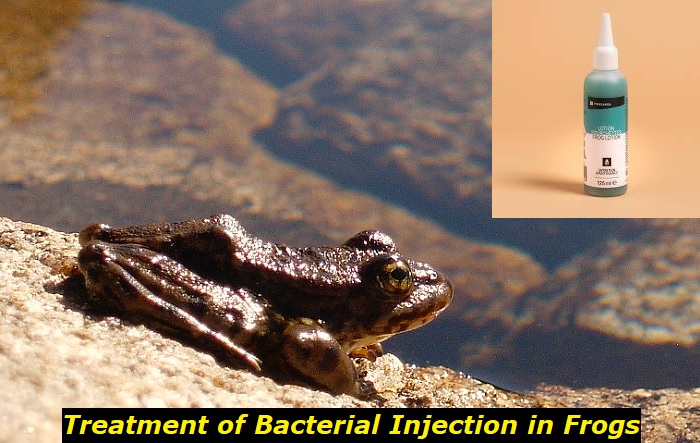Most of us like to think that we know our pets as well as we know ourselves. That is why we get so worked when they do not appear to be ‘themselves’. Whether you are keeping a frog as a pet or for educational purposes, it is important to consider its welfare and care for it responsibly.
If your frog develops a bacterial infection, it is best to act sooner rather than later. Your first step should be to consult a veterinarian who specializes in amphibian care. There are numerous species of frogs, most of which have unique requirements. Only a vet will give you specialized advice that applies to your particular species of frog.

This article will offer general information on how to deal with a frog bacterial infection. We will discuss everything you need to know about:
- Signs of bacterial infection in Frogs
- Typical treatments for bacterial infections in frogs
- How to prevent bacterial infections in frogs
Signs of Bacterial Infection in Frogs
When your frog is fighting off a bacterial infection, it will try to let you know using various signs. Please note that though these signs are indicative of bacterial infections, you must consult a registered veterinarian for an accurate diagnosis and treatment. Booking an appointment with a vet as soon as you notice these signs increases the probability of your frog making a full recovery.
Here are the most common signs of bacterial infections in frogs:
- Abnormal or lethargic behavior – a sick frog will lack the characteristic energy it has while healthy. If your frog suddenly isn’t up for anything but a good snooze, something isn’t right. Inactivity, reduced mobility, sluggishness, failure to respond to stimuli, and other abnormal behaviors may signal that your frog is fighting off a bacterial infection.
- Loss of appetite – whenever your frog can’t be bothered to gobble up their favorite snack, it could be easy to assume they are acting up. Just don’t do it before ruling out bacterial infection. Such infections may cause your frog to lack appetite and interest in food. Be sure to get to the bottom of the problem before your frog loses weight and becomes weakened.
- Difficulty breathing – if your frog is suddenly gasping for air, exhibiting open-mouth breathing, or any other signs of respiratory distress, you may be dealing with a bacterial infection. You should also listen closely to respiratory noises that could indicate your frog is suffering from a bacterial respiratory infection.
- Change in skin texture or color – should your frog’s skin color change to a dull, faded, or discolored tone, you will need to inspect it closer. Any change in texture, e.g. skin feeling slimier or drier, could be an indication that things are going awry. Inspect the skin closer to ensure there aren’t any signs of swelling, redness, or ulcers.
- Abnormal mucous production – when it comes to frogs, it is important to know how much mucus is just right. Inspect your frog’s skin and zero in on its mouth. Check whether there appears to be excessive mucous production. The mucus may appear thicker or slimier than usual. If the mucus appears foamy, contact a veterinarian as soon as possible.
- Skin wounds or lesions are a common sign of bacterial infections in frogs. If your frog has open wounds or sores that may or may not be covered with yellowish or whitish discharge, get them professional assistance before things take a turn for the worse.
- Inflamed body parts – frogs suffering bacterial infection may exhibit redness or swelling in the mouth, limbs, or eyes.
Common Treatments for Bacterial Infections in Frogs
After confirming that your frog is afflicted by a bacterial infection, there are several options available. The most appropriate treatment for your frog will depend on a variety of factors, including its species and the severity of the infection. Your vet will use one (or a combination) of these treatments:
- Antibiotics are often prescribed to treat bacterial infections in frogs
Your vet will work out the required dosage depending on the severity of the infection and the type of bacteria causing it. You must follow the vet’s dosage instructions to the letter. If your frog’s symptoms improve before completing the full course of antibiotics, do not stop administering the antibiotics. Failure to complete the dosage increase the chances of the infection reoccurring.
- Antiseptic solutions
Topical ointments like antiseptic solutions are often used in combination with antibiotics to stop the infection from spreading, ease inflammation, and promote healing.
- Quarantine
If you have more than one frog, your vet will ask you to separate the sick frog from healthy ones to prevent the bacteria from spreading among the population. This will likely require you to dig into your pocket and purchase an additional habitat to relocate all the healthy frogs.
- Care and maintenance advice
Your vet will likely want to figure out what caused your frog’s bacterial infection to help you implement proper preventative measures. Do not feel judged if they ask a barrage of questions regarding how your frog’s housing, environmental conditions, and diet. The vet only wants to know if your maintenance and care routines, e.g. humidity and temperature levels, are appropriate for that particular species. Proper conditions are key for ensuring antibiotics and topical ointments work alongside an immune system that is firing on cylinders.
How to Prevent Bacterial Infections in Frogs
You are likely wondering how to spare yourself the hassle of dealing with a sick frog ever again. You will be glad to hear that preventing bacterial infections in frogs is simpler than you would expect. Prevention and early detection are the best ways to ensure that your frog has a strong immune system that can fight off most bacterial infections the way nature intended – without antibiotics.
Here are the tried and tested ways to ensure that your frog remains a healthy shade of green:
- Ensure your frog’s habitat provides an optimal environment for the species. Ensure the ventilation, filtration, light, temperature, and humidity match those recommended. If you have more than one frog, do not overcrowd the habitat.
- Clean your frog’s habitat, including changing the water periodically. Do not forget to clean the decorations and substrates as well.
- Purchase an additional habitat for quarantining any new frogs you acquire. Quarantining a new frog for at least a week is good practice to spare your older frogs from any infections the new one could be carrying.
- Always wear gloves when handling your frogs. Frog skin is very sensitive and should not be handled with unclean hands because it can easily absorb bacteria. If you had rather not use gloves, ensure you wash your hands thoroughly with antibacterial soap before and after.
- Ensure your frogs have a standard diet that meets all their nutritional needs. Do not feed your frogs wild-caught food, e.g., rodents and insects, because they are teeming with bacteria. Frogs in the wild have stronger immune systems than those bred in captivity. Your frog should not be exposed to the bacteria in wild-caught prey; instead, use commercially bred prey.
- Periodic veterinary care – it is advisable to have a regular veterinarian who specializes in amphibian care on standby for prompt diagnosis and treatment should anything go wrong with your frog. If you do not mind spending a little extra on your frog, consider scheduling an annual check-up.
Things to Avoid When Caring for a Frog
We have already discussed how to keep bacterial infections at bay. However, there are a few additional don’ts that will go a long way in maintaining your frogs’ health. Avoiding the habits listed below will ensure your frog remain as healthy as can be.
- Do not overhandle your frog. You may love your frog, but it does not belong in the palm of your hand. Handling your frog too frequently or roughly increases the odds of transferring bacteria.
- Do not use tap water for your frog’s tank if your water supply is chemically treated. Chlorine and other chemicals are guaranteed to affect your frog’s health.
- Do not feed your frog oversized or inappropriate prey items. Stick to a variety of species-appropriate prey for your frog.
- Do not keep frogs in a tank that is too small or overcrowded.
- Do not forget to maintain a cleaning and feeding schedule that ensures your frogs’ needs are adequately met.
Conclusion
If you suspect your frog is suffering from a bacterial infection, do not hesitate to consult a vet. Do not book an appointment before confirming that the vet has plenty of experience treating amphibians. If your frog is prescribed any antibiotics or topical ointment, ensure you use them according to the instructions. The right vet will ensure your frog has the proper nutrition, a suitable environment, and proper care routines.
Keeping your frog happy and healthy is not rocket science. All you need to do is research the precise needs of your frog’s species and consult an experienced veterinarian.
- Pacman Frog Looks Deflated – What’s Wrong and What to Do? - August 7, 2023
- How to Put Snake Back in Cage after Feeding? Important Concerns - July 31, 2023
- Repta Boost: Instruction, Considerations, Ways to Use - July 24, 2023



